AMD Ryzen Threadripper 7980X & 7970X Review: Revived HEDT Brings More Cores of Zen 4
by Gavin Bonshor on November 20, 2023 9:00 AM EST- Posted in
- CPUs
- AMD
- HEDT
- ThreadRipper
- Zen 4
- Threadripper 7000
- TRX50
Since AMD's Ryzen Threadripper 3000 series rode off into the sunset in 2021, the high-end desktop (HEDT) market has essentially been dead. With desktop processors coming out with higher and higher core counts almost every generation, the very high core counts of HEDT haven't brought the same impact as they once did. Although we still haven't seen 32C/64T and 64C/128T chips on desktops – and who knows if we ever will – the performance that the flagship desktop processors such as Intel's Core i9-14900K and AMD's Ryzen 9 7950 and 7950X3D processors bring to the table is already fantastic. But we still want more, and this is where HEDT comes in.
Given the rapidly progressive nature of desktop platforms over the last 4 or 5 years, is there much benefit to opting for HEDT in 2023? AMD seems to think so, and to that end has brought three HEDT chips to the market in the form of the Ryzen Threadripper 7000 series, ranging from 64C/128T down to 24C/48T, with a 32C/64T in between these for good measure.
| AMD Ryzen 7000 (Zen 4) CPU Comparison | ||||
| AnandTech | Ryzen | Threadripper | Threadripper Pro | EPYC (Genoa) |
| Cores | 6-16 | 24-64 | 12-96 | 16-96 |
| Architecture | Zen 4 | Zen 4 | Zen 4 | Zen 4 |
| 1P Flagship | R9 7950X | TR 7980X | TR Pro 7995WX | EPYC 9654P |
| MSRP | $550 | $4999 | TBD | $10,625 |
| TDP | 170 W | 350 W | 350 W | 360 W |
| Base Freq | 4500 MHz | 2500 MHz | 2500 MHz | 2400 MHz |
| Turbo Freq | 5700 MHz | 5100 MHz | 5100 MHz | 3700 MHz |
| Socket | AM5 | sTR5 | sTR5 | SP5 |
| L3 Cache | 64 MB | 256 MB | 384 MB | 384 MB |
| DRAM Channels | 2 x DDR5-5200 | 4 x DDR5-5200 | 8 x DDR5-5200 | 12 x DDR5-4800 |
| DRAM Capacity | 192 GB (UDIMM) |
1TB, ECC (RDIMM) |
2 TB, ECC (RDIMM) |
6 TB, ECC (RDIMM) |
| PCIe | 5.0 x24 + chipset (x4) |
5.0 x48 + 4.0 x32 + chipset (x4) | 5.0 x128 + 4.0 x8 + chipset (x4) | 5.0 x128 |
| Pro Features | No | No | Yes | Yes |
Looking specifically at the options available with AMD's Zen 4 cores across the entirety of the processor landscape, the above table is a good indicator of how scalable Zen 4 is. The AMD Ryzen 9 7950X, along with the Ryzen 9 7950X3D, represents the best Zen 4 chips on the desktop platform, with 16C/32T, which isn't too far away from the Ryzen Threadripper 7960X with 24C/48T. Of course, the Ryzen 9 7950X is $550, and the Ryzen Threadripper 7960X is $1499. This means that without all of the specific platform features, such as going from dual to quad-channel memory and higher density RDIMM memory, the 7950X is around £34.37 per Zen 4 core, while the 7960X is much more expensive at $62.45 per core. While price per core isn't a linear benchmark of performance or anything like that, it does show that AMD's AM5 platform is much more cost-effective per core than AMD's latest HEDT offerings.
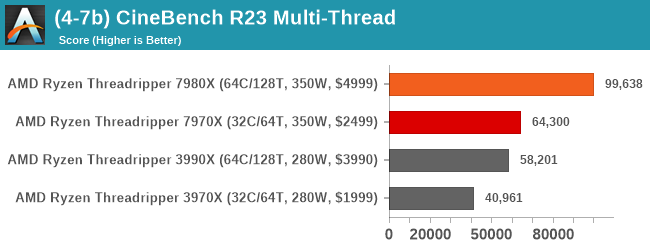
Typically, enthusiasts and power users looking for higher core chips typically have bigger wallets, so cost isn't as much of an issue. The Ryzen Threadripper 7000 is essentially a bridge between AMD's desktop and workstation portfolios, and further beyond this is AMD EPYC, which is designed for server and cloud environments. From our testing, there's a clear benefit for users looking to upgrade from the existing HEDT platforms, such as Ryzen Threadripper 3000, to the new 7000 series. This goes not just for single-threaded performance, but the Ryzen Threadripper 7000 series offers much more potent multi-threaded performance, too. If AMD had opted to launch Threadripper with Zen 3, the gap would have been smaller, but still, Zen 4 is a better and more efficient core architecture, which we've seen in our reviews, including that of the Ryzen 9 7950X3D.
AMD Threadripper 7000 vs. Intel Sapphire Rapids WS: Performance Analysis
Looking at the performance comparisons between AMD's Ryzen Threadripper 7000 and Intel's current Sapphire Rapids Xeon W9-3495X (56C/112T), it should be noted that Intel's platform supports 8 channels of memory while Threadripper 7000 and the TRX50 chipset are limited to 4 channels. This means the W9-3495X has more memory bandwidth than AMD's options. While AMD's Threadripper Pro 7000 WX-series is more compatible with platforms, features, and manageability, the W9-3495X is Intel's flagship workstation processor currently on the market. With a price of $5889, it's not a cheap investment. The Ryzen Threadripper 7980X ($4999) is also similarly priced (i.e. expensive), so it's a worthwhile comparison to make.
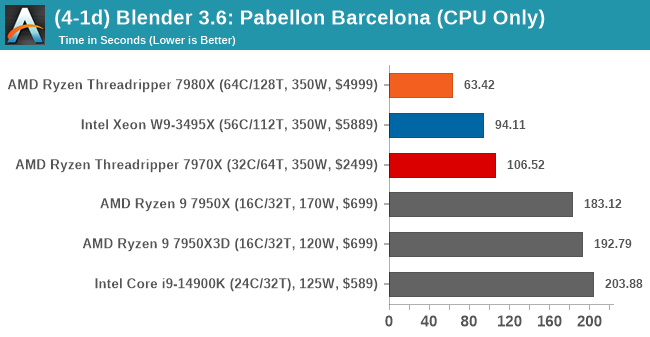
In the longest Blender 3.6 rendering test (Pabellon Barcelona), we can see that the AMD Ryzen Threadripper 7980X ($4999) was around 32% quicker than the Intel W9-3495X. Even the 32C/64T Ryzen Threadripper 7970X ($2499) was only around 11% slower than Intel's flagship workstation chip, showing that it is no slouch in that department. All three of the chips mentioned above are much quicker in rendering than any of the current desktop flagships on the market.
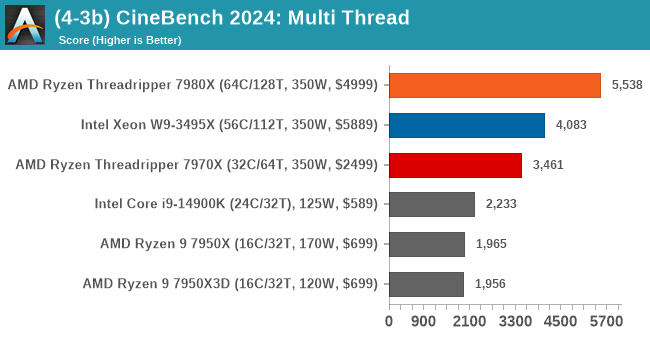
Looking at performance in the latest CineBench 2024 benchmark, we can see similar levels of multi-threaded performance to Blender, where the Ryzen Threadripper 7980X is around 35% ahead of Intel's W9-3495X despite having just 14% more cores. Even the 7970X (32C/64T) shows it's good at rendering, as it's around 18% slower than the W9-3495X, with 42% fewer cores.
It's clear that in multi-threaded rendering performance, the AMD Ryzen Threadripper 7980X ($4999), despite having eight more cores than the W9-3495X ($5889), half the memory channels (4 vs. 8) and being ultimately cheaper, it is the better option. Even the Ryzen Threadripper 7970X ($2499) isn't too far off in rendering performance compared to the W9-3475X and, at less than half the price, really punches above its weight compared to what Intel is offering in the HEDT/workstation space. Threadripper 7000 also decimates the desktop chips in multi-threaded performance, especially where all of the cores can be optimally utilized, such as in rendering.
AMD Threadripper 7000 vs. Desktop Flagships: Performance Analysis
While it's clear in multi-threaded workloads such as rendering, the Ryzen Threadripper 7980X and 7970X are more potent with higher core counts, there are certain situations where the current desktop flagship processors still represent a better buy.
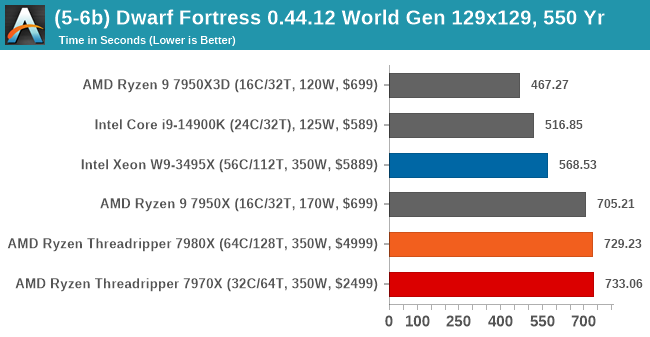
Looking at the performance in Dwarf Fortress, we see that the Threadripper 7980X and 7970X don't do as well in this situation as the desktop chips do. Balancing lower core counts with higher core clock speeds, such as the 6.0 GHz Intel Core i9-14900K ($589), provides better performance when more cores aren't as advantageous as a higher core frequency. Where having higher core clock frequencies is important, we must note that the Threadripper 7980X has a turbo core clock speed of up to 5.1 GHz, while the Core i9-14900K can reach up to 6.0 GHz, which, with its 24-cores, still performs exceptionally well. And even in a pure AMD match-up, we're looking at a 5.8GHz 7950X versus the 5.1GHz Threadripper processors.
Meanwhile we have the uniquely awesome AMD Ryzen 9 7950X3D, which has 96 MB of L3 3D V-Cache on one CCD. The 7950X3d still provides better benefits in simulations, and where L3 cache can be utilized, it gives AMD's 3D V-Cache enabled chips a solid advantage in these situations. Even though the Threadripper 7980X has 256 MB of L3 cache in total, this is split into 8x CCDs, each with eight cores and 32 MB per CCD, so Threadripper runs into the latency costs of going off-die (and through the I/O Die) to access additional L3 cache.
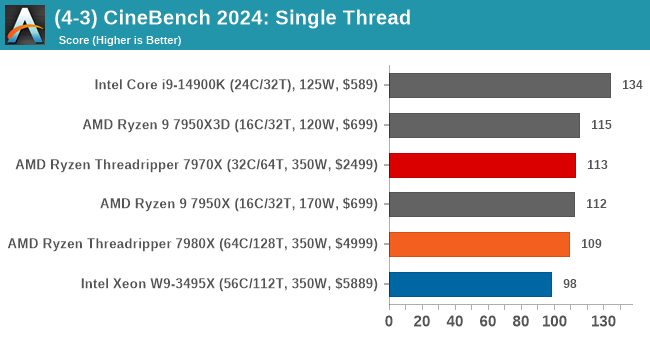
Another situation where higher core frequencies are key is in single-threaded workloads, and as we can see in CineBench 2024 ST, the Core i9-14900K with turbo clock speeds of up to 6.0 GHz reigns supreme here. Whereas bringing up the rear is the Intel Xeon W9-3495, which has a turbo clock speed of 4.8 GHz. Ultimately there's nothing here that is a surprise, but it confirms the basic assumption that these many-core workstation ships aren't going to be able to match the single-threaded performance of a flagship desktop chip.
Final Thoughts: Is HEDT Back? AMD Thinks So
Both the Ryzen Threadripper 7980X and 7970X are designed for situations where high core and thread counts translate directly into more performance. For users involved in industries and use workloads such as video editing, 3D rendering, and large-scale data processing, the 7980X offers a distinct advantage with its 64 cores/128 threads over conventional desktop processors. Faster rendering times in complex projects mean users can render projects quicker, thus saving valuable time. Even the 7970X, with its 32 cores, is well suited for workloads such as content creation and rendering tasks.
AMD's Ryzen Threadripper 7000 series offers a cut-down and cheaper alternative to the Ryzen Threadripper Pro 7000 WX-series, which is also suitable for these tasks but comes with AMD Pro/manageability features designed for professional environments. Although AMD hasn't unveiled pricing on the Threadripper Pro 7000 WX-series processors, these will undoubtedly cost much more.
Considering the high investment for the Ryzen Threadripper 7980X and 7970X, potential buyers must weigh their performance needs against the cost. While the higher core and thread counts of the 7980X ($4999) command a premium price, they offer better multitasking capabilities than current desktop processors, making them a worthy investment for professionals whose time savings translate to significant financial benefits. The 7970X ($2499), positioned at a lower price point, provides plenty of power for most tasks and workloads, giving users a more cost-effective solution for those needing more performance without needing the top-tier performance of the 7980X. This pricing structure isn't linear to AMD's current Ryzen 7000 desktop pricing, and for things such as gaming, these are much better suited with faster core frequencies.
As the landscape continues to evolve, AMD's position with the Threadripper 7000 series makes a statement in the HEDT market, but is HEDT viable today? Analyzing the cost a little further, AMD TRX50 motherboards are certainly more expensive than AMD's desktop AM5 motherboards, and the cost per Zen 4 core on Threadripper 7000 is much higher than Ryzen 7000. The crux of the matter comes down to workflow, tasks, and requirements; Threadripper 7000 excels in tasks such as rendering, where having more cores and threads directly translates into more performance. For most users, though, Ryzen 7000 or even Intel's 14th Generation Core family will satisfy most users' demands.


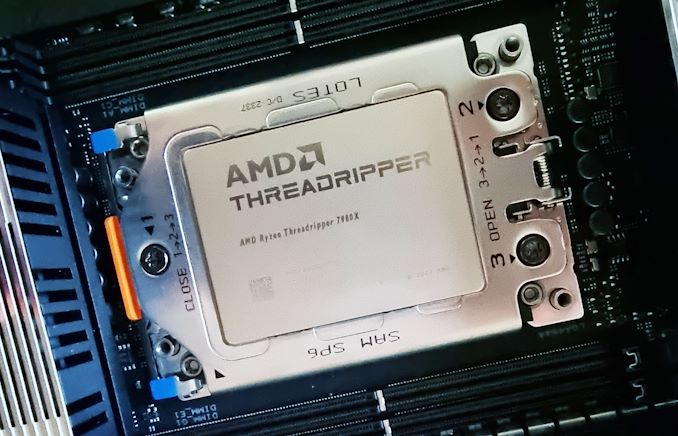








66 Comments
View All Comments
Jansen - Monday, November 20, 2023 - link
Bit disappointing that the memory controller only supports DDR5-5200, considering that JEDEC compliant DDR5-6400 RDIMMs are available.Ryan Smith - Monday, November 20, 2023 - link
At the end of the day it's the same I/O die as Genoa. So it comes with roughly the same restrictions.TEAMSWITCHER - Monday, November 20, 2023 - link
Not surprised by this at all. My 3960X Threadripper system was never able to run 64gb (16gb x 4) at even the promised DDR4-3200 speed. I tried three different RAM kits and even a different CPU (replaced by AMD) and the problem never went away. In the end I believe it to be motherboard issue, it was simply incapable of running stable with any RAM faster than DDR-3000.After spending so much on the ASUS Zenith II Extreme Alpha motherboard, 64GB of DDR-3600 RAM, and a $1400 CPU, the end result was very disappointing. Support from ASUS, AMD, and G-Skill was a long process, and eventually I had to just accept what was working and move on.
Ultimately, I don't believe that AMD and ASUS can properly deliver and support any HEDT platform that is worth the money they ask for it. I sincerely wish Intel would return to this segment, as I never had a problem with my X99 Deluxe II motherboard.
lemans24 - Monday, November 20, 2023 - link
Intel is definitely in HEDT with their xeon w-2400 chipsStormyParis - Monday, November 20, 2023 - link
I've blacklisted Asus. Lots of issues with both specs, reliability, and service.vfridman - Monday, November 20, 2023 - link
I have two systems with 3990X and two systems with 3970X, ASUS Zenith II Extreme Alpha motherboard and 256GB of 3600 speed G.Skill RAM in each system. All runs perfectly and completely stable, even with maxed out PBO overclock. I regularly run compilation jobs that require almost entire 256GB of RAM and never experienced any problems. I suspect you got unlucky with your CPU memory controller.Mikewind Dale - Tuesday, November 21, 2023 - link
I have a ThreadRipper Pro 3950X on a Supermicro WRX80 motherboard. I run 8x64 (512) GB of Supermicro-branded DDR4 3200 ECC RDIMM without a problem.Adam7288 - Wednesday, November 22, 2023 - link
Same exact config! Ram Bros.tygrus - Saturday, January 6, 2024 - link
How are you going with those >200GB matrices & statistics?Many years ago I had to use raw frequency stats, then a program to generate blocks of SAS code that could analyse cross-tab by cluster (weighted) with smaller subsets of interest from every possible combination (multi-morbidity data). Making sure the stats methods still gave correct results. Divide & conquer to fit in limited RAM of circa 2013 computers. In those days it was mostly constrained by single thread & disk/network IO speed (~100MB/s).
TEAMSWITCHER - Friday, November 24, 2023 - link
Ya know.. I have yet to build an AMD system that didn't suffer from some kind of issue. I don't think I'm unlucky either. I need to stop buying AMD gear thinking... "this time will be different." Because it never is.